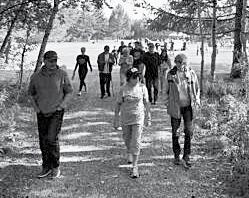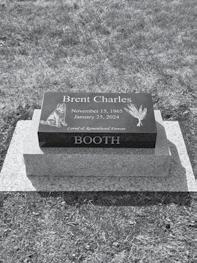

















The Midtown Medical Clinic is excited to welcome three new doctors who have recently begun their practice in Vermilion. All originally from Libya, these physicians have embraced Vermilion’s small-town charms, and they are eager to make a positive impact on the health and well-being of its residents.
Dr. Akrm Krimeed, who has been practicing medicine for one month in Vermilion, hails from Libya, where he specialized in anesthesiology and family medicine. When asked what drew him to a small town in Alberta, Dr. Krimeed said he had seen an ad for the position and was immediately interested. The opportunity to work in a close-knit community was appealing, and he says the support he has received here has been incredible.
Despite the challenges of limited imaging facilities, he is confident in the supportive team at Midtown Medical Clinic and is looking forward to growing both personally and professionally in this new environment. Although his wife is currently working in Lloydminster as an audiologist, Dr. Krimeed is committed to getting involved with the local community and hopes to build lasting friendships. With four months of practice in Vermilion under his belt, Dr. Omar Abugharsa is no stranger to rural living. Also from Libya, Dr. Abugharsa has always preferred the tranquility of smaller communities. “The environment here is beautiful, with the river and all the trees,” he said. He is looking forward to raising his five children, who range in age from four to fourteen, here.
Dr. Abugharsa recognizes the chal -
lenges of practicing medicine in a rural setting, particularly the limited availability of imaging facilities. “Ultrasound is crucial for our work, and having access to it on weekends would be a huge improvement,” he noted. However, he remains optimistic and is determined to provide the best care possible with the resources available. The transition to life in Vermilion has been an adjustment for his family, but they are adapting to the differences in culture and work practices with the encouragement of those around them.
Dr. Ashraf Al Oud brings 15 years of experience in family and emergency medicine to Vermilion, having practiced in Libya before making the move to Alberta. After living in small communities for most of his life, Dr. Al Oud sought out Vermilion as a safe and welcoming place to raise his three young children, aged two, six, and
seven.
The local Doctor Attraction and Retention Committee and the support from both the clinic and hospital teams have made his transition smooth. While he acknowledges the challenges of dealing with emergencies that sometimes require transferring patients to more advanced facilities in the city, Dr. Al Oud appreciates the support from urban specialists and is confident in his ability to manage these situations.
Dr. Al Oud is particularly enthusiastic about getting involved in the community and getting to know more of Vermilion’s residents.
The Midtown Medical Clinic is thrilled to have Dr. Krimeed, Dr. Abugharsa, and Dr. Al Oud on board, and the people of Vermilion can look forward to benefiting from their diverse expertise and dedication in the years to come.
Caylie Gnyra Reporter
On August 23, local farmers and ranchers gathered at Round Rock Ranching southeast of Vermilion for the Alternative Land Use Services (ALUS) Project Tour and Pasture Pipeline Demonstration. The event aimed to highlight innovative practices in sustainable agriculture and water management.
The morning began with a presentation by Barry Irving of Pasture Pipeline, based in Sherwood Park, who started the discussion at 9:30 a.m. Irving provided insights into the evolving climate conditions in the region, noting that while the area may experience less snowfall in the winter, it is expected to see more rainfall at different times throughout the year. This shift in precipitation patterns underscores the importance of effective water management for agricultural operations.
Irving shared his expertise in pipeline technology, emphasizing the advantages of using pipelines for water distribution on farms. “The nice thing about pipelines is you can put them wherever you need, and the cost of doing them is considerably reasonable,” he explained. He highlighted the durability and reliability of high-density pipe, which can be purchased in bulk. “Fusing pipe for thread ends and T’s is the preferred method of joining pipe together or transitioning from pipe the standard threads; if it’s done right, it doesn’t fail,” Irving assured the attendees.
One of the key takeaways from the presentation was the importance of installing pipelines at the correct depth. “Water from a pipeline is cool as cool can be, if the pipeline is buried or if grass can grow overtop of it to provide shade. Typi cal burial depth is 12-16 inches. Most farming only goes about 6 inches down,”
Irving noted, emphasizing that proper installation ensures the effectiveness of the system.
The event also provided valuable information on funding opportunities available to farmers for implementing such sustainable practices. Federal funding through programs like OFCAF (Off-farm Climate Action Fund) was discussed, which provides 85% funding for projects like cross-fencing, pipelines, and solar pumps to distribute water. Additionally, the Resilient Agricultural Landscape Program (RALP) offers 100% funding for certain projects. ALUS also provides funding for these kinds of initiatives, as well as support for applications. Irving encouraged farmers to start working on their applications early, especially during the winter months before the applications open up. “It’s first in, first funded,” he reminded the group, noting that all of these organizations have limited amounts to cost share on projects each year.
Irving shared cost estimates for pipeline installation, noting that 2-inch pipes are currently priced at approximately $2.00 per foot, but recommended using $2.50 for budget purposes to be safe. 1.5” pipe runs about 30 cents a foot cheaper, but can water fewer cattle. The rule of thumb is that 200 pairs can be watered at 2 miles of 1.5” pipleline length, but exceeding either may require a move to 2” pipe. “We supply the pipe, deliver it, and plow it in using your tractor,” he explained. He also mentioned that the cost of pipeline materials can fluctuate based on oil prices, as pipe is an oil-based product.
Irving’s talk included a discussion on the benefits of using gravity for water distribution. “Gravity energy is the cheapest and most reliable form of energy you have,” he said. He advised that while


there may be a cost each year to blow out the system for winter, properly maintaining the system is worth the investment in the long run.
Following Irving’s talk, the group gathered around two of his pieces of pipelineploughing equipment, examining how they work in the context of water management. They then broke out into pickup trucks that took them down the gravel road and through some of Round Rock Ranching’s fields, stopping just outside a small wetland on the property.
Chris Elder, ALUS County of Vermilion River Program Coordinator, talked about this site as the first ALUS project in Alberta. This project, initiated in 2010, focused on protecting a wetland area that cattle previously had access to. Native grasses were planted to filter water, and a row of trees was established to create a buffer zone, protecting the wetland and enhancing biodiversity. Elder emphasized the importance of diverse plantings, recommending species like saskatoons and chokecherries to build resilience in agricultural landscapes.
Elder then led the group to a second site, where Sean McGrath, who serves as the chair of ALUS’ County of Vermilion River Partnership Advisory Committee and part of the family of operators of Round Rock Ranching, spoke of piping water up a hill to draw cattle up to an area that had been left ungrazed. He described the system as providing access to extra
cow days. As he spoke, Irving and his wife were at work beginning to lay more pipe. In fact, the timing of the installation had provided the foundation for this educational tour, and all of the attendees were from a 20-minute radius, highlighting just how much one project can multiply into ideas that can transform numerous surrounding operations.
The last stop on the tour was to learn about research being done with the University of Alberta on adding legumes to pasture. Elder emphasized that with all of ALUS’ projects, producers are the project managers, and that ALUS provides support with project planning, partnership connections, establishment funding, and ongoing annual payments for project management and maintenance. Their hope is to continue offering half-day tours of local farm projects to further educate producers on the possibilities that can come from submitting an application for funding.
For more information on ALUS projects and upcoming events, visit https://www. alus.ca or the County of Vermilion River’s Facebook page. To indicate interest in exploring an ALUS project on your farm or ranch, visit https://alus.ca/become-aparticipant/
To learn more about solutions for piping water, visit https://www.pasturepipeline. com/ and to learn more about Round Rock Ranching’s projects, visit www. roundrockranching.com/




Lorna Hamilton Reporter
On August 23, the Vermilion community members gathered at Webb’s Ford to celebrate the 90th birthday of Herb Jamieson, a man whose life story is as rich and diverse as the community he has long called home. Herb’s family organized a heartwarming come-andgo lunch, where guests enjoyed sandwiches, wraps, a cheese and meat platter, and a delightful array of cupcakes, all in honour of a man who has lived an extraordinary life.
Herb was born on August 23, 1934, in Okanagan Landing, British Columbia. At the age of 20, Herb took a significant step that would shape the rest of his life—he joined the Canadian Air Force. His first posting took him to Saint Jean, Quebec, and he later attended Trade School at Canadian Forces Base Borden in Ontario, honing skills that would serve him well in his future endeavours.
Herb’s journey with the Air Force even tually brought him to the 4 Wing Canadian Forces Base in Cold Lake in 1973. It was here that he spent six formative years teaching winter survival, a role that show cased not only his expertise but also his dedication to service. Herb’s career in the Air Force spanned 26.5 years, a period during which he built a reputation for hard work, reliability, and an indomitable spirit.
In February of 1980, Herb made another life-changing decision: he moved to Vermilion and purchased a house. Just a few months later, in May of 1980, he applied for a position as a fertilizer technician with Webb’s Fertil izer, then owned and managed by George, Lawrence, and Scott Webb. Herb’s interview lasted just 10 minutes, but it was long enough for the Webbs to recognize his carpentry skills and the wealth of experience he brought with him. Herb walked out with the job, and as he fondly recalls, “I literally came out of the interview 10 minutes later with the job, mainly because they found out I could do carpentry. I’ve been working with Webb’s group of companies ever since.”
For over four decades, Herb has been a fixture at Webb’s, contributing his skills and expertise to the company and forming lasting bonds with colleagues. Although he officially stopped working full-time in May 2024, Herb continues to lend a hand whenever needed. With a chuckle, he shared, “I keep coming in to do work because I haven’t gotten a pink slip yet, and I will continue working until I can’t anymore.” Herb noted that staying involved with the work gives him a reason to get up in the morn ing, a sentiment that reflects his endur
ing commitment to staying active and engaged.
As family, friends, and community members gathered to celebrate Herb’s 90th birthday, the atmosphere was filled with admiration and affection for a man who has given so much to his country, his community, and the people around him. The event was a perfect reflection of Herb’s life—full of warmth, good company, and a sense of purpose.
Herb Jamieson’s life is a testament to resilience, dedication, and the importance of staying connected to one’s roots. As Vermilion continues to thrive, it is the presence of individuals like Herb that enriches the community and serves as an inspiration to all. Herb Jamieson was described by many in attendance as —a man who has lived 90 years with dignity, humour, and an unwavering spirit.












Dawn Hames Columnist
The harvest season on the farm, has come up fast. My husband has started swathing, and the garden is producing an array of produce. It is officially zucchini season. Only two zucchini plants produce a plethora of amazing fruits, and yes, they are technically fruits. Zucchini, also known as summer squash, are high in several minerals, and many vitamins including five different B vitamins, vitamin C and K. The skin of a zucchini is 2 – 10 times higher in beneficial carotenoids, so by all means eat with the skin on, especially if they are from your garden

Craig Baird Columnist
or a neighbor’s garden that does not use chemical spray. Zucchini is a good source of fiber at 2.5 grams per cup. Surprisingly zucchini contains omega 3 essential oil. Zucchini are low in calories and full of nutrients. If you did not grow any, there should be lots of fresh organic ones at the local farmer’s market. The dill is ready and in abundance this time of year, as it has self-seeded from other years.
Onions are a great source of the nutrient quercetin, and the good news is that cooked onions retain this beneficial nutrient, undamaged by the heat. Quercetin is a flavonoid that may inhibit the growth of certain cancers. Quercetin has been shown to lower bad cholesterol, raise good cholesterol and be protective of the
cardio-vascular system. Onions are a natural source of both quercetin and chromium, which both assist in blood sugar control. Onions and garlic contain sulfur compounds that work to detox our bodies by binding to heavy metals such as lead, mercury and cadmium and then escorting them out of the body.
This soup is literally and alphabet soup of beneficial vitamins, minerals, antioxidants and phenols. I used a lot of dill in the soup, but feel free to start with half the amount and then add more if you would like. I add in the dill stems straight into the soup, and they impart even more dill flavour.
Zucchini and Dill Soup 1 pound of burger 1 tablespoon oil or lard
2 cups onion, chopped
2 cups potato, cubed
1 can tomatoes
5 cups water
2 cups zucchini, cubed
2 tablespoons dill, finely chopped
2 dill stems, whole
3 cloves garlic, finely chopped
2 teaspoons sea salt
1 teaspoon pepper
1 cup chopped green onion
Brown the burger, in the fat. Add all the onions and potatoes, and cook until some browning is happening. Add the rest of the ingredients except the green onions. Cook until the potatoes are cooked. Add in the green onions in the last few minutes of cooking. Discard the dill stems. Season to taste with additional salt and pepper.
On Aug. 5, 1940, farmers in the Vermilion area woke up to a beautiful summer morning. Then, everything turned sour when they looked outside.

Farmers discovered millions of beet web worms on the march throughout the district, rapidly stripping gardens bare. When farmers went to bed the night before, they had lush gardens. When they woke up the next day, they found their gardens were empty of everything. While the farmers were surprised, they shouldn’t have been. There was a warning the day before that the web worm was approaching the community. On Aug. 9, the Edmonton Bulletin reported, “A plague of beet web worms is approaching Vermilion from the west. It

was reported yesterday they had attached the beets in the hospital garden. Today’s report is that they have finished the beets and are attacking the carrots.”
At the school of agriculture, dozens of phone calls came in after the worms appeared and farmers asked how to deal with them.
The beet web work resembles a caterpillar, and they can appear suddenly, to the great surprise of farmers and gardeners. The agricultural college told those who called in that to combat against the beet web worms, poison could be used, along with trenching. Putting a deep furrow around the garden, especially on the side where the web worms enter, was the best option for dealing with the pests. The ground had to be turned
away from the garden, as the web worms spun webs as they crawled and could bridge the furrow. Hence, why poison was recommended at the time as another means of defence. All of this was well and good, but many of the farmers had lost much of their gardens already to the pests. It was late in the season, and would be hard to grow something else in the garden before the autumn arrived. Vermilion wasn’t the only place that was hurt by the beet web worms. In Gadsby, about an hour to the south of Vermilion, was also hit by the pests.
Contact Craig at craig@canadaehx. com
Support Craig by donating at www. canadaehx.com (Click Donate) Listen to his podcast Canadian History Ehx on all podcast platforms.









Parkinson Association of Alberta:
Submitted Parkinson Association of Alberta (PAA) is pleased to announce its 12th Syndromes. This peer-to-peer fundraising event serves to celebrate the victories of people affected by PD and PD+, as
together thousands of Albertans across the Province, and in Yellowknife, and be supported by inspirational messages on-site by PAA Executive Director Lana Tordoff, Board Chair Dr. Cara Ferreira and other members of our Board of Directors, as well as other special guests.

Over 15,000 Albertans are currently living with Parkinson disease (PD) and Parkinson’s Plus Syndromes (PD+), with thousands more affected as caregivers and family members. Parkinson disease is the fastest growing neurological disorder in the world, and rates are increasing. There is currently no
About Parkinson Association of Parkinson Association of Alberta provides almost $2 million directly towards support services, programs,





education, advocacy, and research to the Parkinson’s community in and across Alberta annually. With no permanent or consistent funding from outside sources, including Government, PAA relies on the generosity of donors, grants, memberships and fundraising initiatives to provide the necessary funds.
Step ‘n Stride is our largest fundraiser of the year and accounts for over 20% of our annual budget.
Parkinson Association of Alberta is the source for support, education and inspiration for people impacted by Parkinson disease and Parkinson’s Plus Syndromes, and engagement in important quality of life research with an emphasis on Alberta.
For more information on Parkinson Association of Alberta please visit http://parkinsonassociation.ca





Through Grief Society
Submitted September brings a new season, and for many, a new phase of grieving and loss. Fall can offer many opportunities to reflect and work through times of grief. One way to bring attention to your grief and allow for reflection, is using a helpful practice, journalling.
The Greater Good Science Center (2020), based at the University of California, Berkeley, identified several benefits to journalling including an opportunity to open up, to disclose emotions, to give our heads space, and to form a coherent story of our experiences. Journalling can be very powerful throughout our grieving experiences because there is no judg -
Lorna
Hamilton Reporter
Vermilion’s Main Street is set to come alive on September 6 with the muchanticipated Vermilion Street Jamboree. This 2nd year event promises a seamless blend of exquisite cuisine and captivating
ment coming from a piece of paper. A journal simply provides a space to capture our true thoughts and feelings. For many, it can feel intimidating to stare at a blank page and begin to journal. A few points for consideration to get yourself started might be whether there is a preferred time of day to journal, a preferred space to sit to journal, and a preferred secure and safe space to store your journal. Setting up these logistics of journalling can help tackle some of the fears around starting this practice.
If you still feel concerned about where to start with journalling, The Grief Recovery Centre out of Houston, Texas, suggests some of the following journalling prompts: Today, I’m having a hard time with…
Describe a memory with your loved one that makes you laugh.
Describe a memory with your loved one that makes you cry.
Write about where you feel grief in your body.
Do you feel comfortable asking for help? Why or why not?
Create a mantra you can return to when you feel overcome with grief. What songs make you think of your loved ones?
What is something you need from your support system?
What is one way you can celebrate your loved one’s memory?
What are some activities I can prioritize for myself to do daily or weekly?
live music, creating an unforgettable experience for all in attendance.
Organizing partners the Vermilion & District Housing Foundation and FOCUS are orchestrating this unique affair with festivities commencing at 5 p.m., with a steak dinner professionally catered by the
Housing Foundation at 6 p.m.. The menu boasts an array of delectable offerings including steak, roasted potatoes, Charred Caesar salad, and dessert. Attendees seeking to complement their culinary experience will find adult beverages at Copper Cork Distillery’s cash bar.







With the journalling process, you may find that you move away from prompts and begin to take more of a free-writing approach. You might find that you start by expressing emotion through your writing and eventually shift to more of your overall thoughts about the grieving process. It can be both challenging and enlightening to go through this experience. If you feel like you could use some extra support with journalling and with processing the emotions and thoughts that come up, then it may be beneficial to reach out to a counsellor.
Funded by FCSS; City of Lloydminster, Towns of Vermilion and Wainwright, Villages of Kitscoty and Marwayne and County of Vermilion River.
Dawn Riley, FOCUS’s Special Projects Director, emphasizes the dual purpose of the event - to raise funds for FOCUS and to contribute to the broader community by supporting the Vermilion Public Library and CLASS. Riley affirms, “It’s not just an event; it’s a collective effort to strengthen our community bonds and to help raise funds and awareness regarding the large area in which both our organizations serve.”
Adding to the evening’s charm, local musician Cassie Cameron will grace the stage, with her melodies. Following her supper/dinner performance, Edmonton’s renowned band, The Oddibles, will take over, promising a musical journey spanning rock, pop, country, Motown, and R&B genres, tailored to the audience’s preferences at 8 p.m. which can also be attended for $20 if unable to attend the supper portion of the event.
In addition to the culinary and musical extravaganza, the event will serve as a platform for local community service groups to set up informative booths. Riley emphasizes the significance of this interaction, stating, “As our community evolves, it’s crucial for these service groups to connect with newcomers, including college students, and familiarize them with the range of services available.”
Anticipating concerns about inclement weather, Riley is prepared. “We have a contingency plan in place. If the weather takes an unfavourable turn, we have secured the Elks Hall to ensure a seamless event,” she assures.
Tickets for this event are priced at $60 per person, or groups can secure a table for eight at $420. Interested individuals can purchase tickets by contacting Dawn Riley at 780-853-4121 ext 5 or Brittany Bratrud at 780-853-5706 or email through email streetjamboree@ focussociety.ca


Caylie Gnyra Reporter
Lakeland College’s Feast on the Farm, an annual fundraising event, once again proved to be a resounding success, raising a net total of $82,000 to support student-led initiatives. Held under a large tent on the Vermilion campus near the Dairy Learning Centre, the event drew more than 250 attendees, making it a sellout affair.
Georgina Altman, Vice President of External Relations and Infrastructure at Lakeland, praised the event, calling it a “wonderful evening.” The funds raised are set to fuel various student-led projects, much like the previous year when human services students organized a Mental Health Day featuring keynote speaker Jody Carrington. “It truly was student-led,” Altman said, noting that staff provided gentle guidance while allowing students to take the lead. This was just one example of the student-led projects taken on by the various schools throughout the institution.
The evening was sponsored by Cenovus Energy, returning as the title sponsor. “They’re such great supporters and really recognize the work that we do in the region, and that is so important, and we’re so appreciative,” Altman added.
The event featured a silent auction and special segments like a student panel. The panel was hosted by current student Tyler Bendfeld and recent alumnus Hanna Tataryn, who both did an excellent job engaging the audience. Attendees were particularly interested in hearing from the recent graduates on the panel, who shared their experiences and insights on life after Lakeland during the discussion.
Live entertainment was provided by Jordyn Pollard, a Saskatchewan Country Music Award winner and a Lakeland alumna.
Pollard’s performance was met with great enthusiasm. “She was brilliant and did a really wonderful job. She was pleased to be there, and we were pleased to have her,” said Altman. The event’s setup, including decorations and cleanup, was a collaborative effort between Lake -
In the August 20th issue of the Voice in the Town Council article the information regarding Jolan Wong (nee Brunner) was incorrect, it is actually Jolan Wong (nee Brunner), formerly of Vermilion, is competing in the Para-Olympics member of the Women’s Canadian National Sitting Volleyball team.




land staff and students, highlighting the community spirit that defines the college. Many hands came together to ensure that the evening was as enjoyable as it was successful.
Reflecting on the night, Altman expressed her gratitude for the support the college receives from both local residents and those who traveled from places like Edmonton. “This one felt like the best ever,” she said, emphasizing the camaraderie among attendees.
The meal, which featured stuffed
chicken and brisket, was designed to offer a farm-to-table experience, although commercial complexities prevented the full realization of that vision this year. Nonetheless, the quality and spirit of the event were undeniable, making it a memorable occasion for all involved.
Feast on the Farm continues to be a cornerstone event for Lakeland College, not only as a fundraiser but also as a celebration of the college’s vibrant community and its commitment to student success.





We will be:







Pest Inspectors will be out in August and September surveying for crop pests and diseases in the County of Vermilion River.
checking canola fields for clubroot
sampling wheat fields and canola fields for the provincial Crop Pest Surveillance
Program
surveying for grasshoppers in municipal roadsides and pastures/hayfields.
Field biosecurity is important, so Pest Inspectors will follow provincial protocols for crop sampling, including disposable booties and sanitation of all tools to prevent the spread of disease.


For more information on Crop surveys, contact the County Ag Department at 780-846-3301 or carychuk@county24.com


















Lorna Hamilton Editor
Wow! Where has the summer gone? I am pretty sure this summer went even faster than last year. It was just a blink and it was over. I can hardly believe that September 1st is this coming Sunday and with that the excitement of a fresh school year is upon us. Students, parents, and educators are now gearing up for another year of learning, discovery, and development.
Beyond textbooks and classrooms, school is where our children have the opportunity to expand and form friendships and their character. Each school year marks a chance for new beginnings and provides children of all ages the opportunity to move
forward in their personal advancements. For students, this journey is a chance to explore passions, develop critical thinking, and nurture creativity. Interactions with peers and teachers help build communication skills, and the ability to work in a team environment; providing them with the muchneeded skills to succeed in the real world.
Teachers serve as guiding forces, igniting curiosity and shaping futures. Their dedication extends beyond the curriculum and inspires students to question, challenge, and strive for excellence in their dayto-day tasks.
While teachers play a vital role in the everyday lives of their students parents also play a significant role, providing support
and involvement that lays a foundation for success. Whether it’s assisting with homework or engaging in meaningful conversations, parents contribute to well-rounded development, so be sure to talk with your children each day as they come home to find out how their day went and to see if they need any assistance with their homework.
Education thrives in a collaborative environment that values open communication, diverse perspectives, and a sense of belonging. Schools should foster this culture, encouraging dialogue and nurturing an inclusive community.
Amidst this excitement, it’s crucial to ensure back-to-school safety. Whether walking to school or using the bus, safety
measures are paramount. Parents and schools must work together to educate students about road safety, stranger awareness, and proper use of transportation, and as a community, we need to be vigilant when we are travelling in school zones! Over the past two months or so our school zones reverted to the normal 50km speed zones, be mindful that starting on the first day of school the speed limits will be changing back to 30km zones.
By prioritizing safety alongside education, we can make this school year not only a time of growth and learning but also a time of security and preparedness. Wishing everyone a happy and safe school year.
Lorna Hamilton
Editor
Amid the educational hustle, one crucial factor remains sidelined: children’s diets. As students prepare to return to school, the spotlight shifts to the significance of providing nourishing meals that fuel their bodies and minds.
Nutrition’s Link to Academic Performance
Proper nutrition correlates with improved cognitive function, better concentration, and academic excellence. For school children in crucial developmental stages, a balanced diet is paramount. Studies consistently highlight how nutrient-rich meals enhance focus, energy levels, and memory retention, bolstering optimal learning.
In the era of rising allergies, catering to dietary restrictions like nut allergies is vital for a safe learning environment. Crafting nut-free meals can be simple and delectable.
Swift, Nut-Free Meal Ideas
Protein Wraps: Lean protein like chicken or hummus, coupled with vibrant veggies, in a whole-grain wrap.
Bento Bliss: Compartmentalized lunchboxes with cheese, whole-grain crackers, fruits, and carrots, offering both balance and appeal.
Wholesome Pasta: Whole-grain pasta drenched in marinara, with lean meat or roasted vegetables, delivering ample school-day sustenance.
Yogurt Parfaits: Layer low-fat yogurt, granola, and fruits like berries, a calcium and probiotic-packed delight.
Veggie Omelet: Egg white omelet loaded with spinach, tomatoes, and bell peppers, a quick protein boost.
DIY Trail Mix: A blend of dried fruits, whole-grain cereal, and seeds, excluding nuts, a nutrient-dense snack.
Creating a nutritious school meals are vital for you childrens health and performance. Schools, parents, and communities
must unite. Nutrition education empowers kids to make smart food choices. Engaging children in meal planning instills ownership.
Beyond packed lunches, low-cost hot lunch menus grace our schools each year. These menus offer diverse, budget-friendly options, ensuring children access wholesome meals. It’s a collaborative effort to promote health and academic vigor.
As students return, remember: their plates are as crucial as their textbooks.

Drive distraction-free
Be ready to stop at all times
Slow down, pay attention and obey all school zone speeds


Wait patiently for children to fully cross the street before you proceed
When travelling behind a bus, follow at a distance that will give you enough time to stop once flashing lights are activated
Watch for children darting across the street


Lorna Hamilton Reporter
In an ideal world, especially in a small town like ours, we should not have to worry about the safety of our community children when school starts, but let’s face it no town is completely safe, and dangers can and do lurk around every corner whether we want to believe it or not.
As parents and guardians gear up to send their children back to school, ensuring their safety remains a top


priority. While our small town offers a unique and close-knit environment, it’s essential to be vigilant and proactive in safeguarding our young and teenage children. Here are some steps to help keep your children safe during the school year:
1. Establish Open Communication: Maintaining an open line of communication with your children is the cornerstone of their safety. Encourage them to share their experiences, concerns, and any unusual incidents they come across at school. This ensures you’re aware of their daily activities and can promptly address any issues that might arise, especially in the world of drugs which much more prevalent in town than some may want


2. Get to Know School Person -
In a close-knit community, building relationships with school staff is easier than ever. Attend parent-teacher meetings, school events, and volun -
teer opportunities to familiarize yourself with the teachers, administrators, and support staff. This not only helps your children feel more secure but also enables you to collaborate effectively in maintaining their safety.
3. Teach Safe Travel Habits: For children who walk or bike to school, imparting road safety knowledge is crucial. Remind them to cross streets at designated crosswalks, follow traffic signals, and wear bright clothing or accessories for better visibility.
4. Cyber Safety Education: In today’s digital age, online safety is as important as physical safety. Equip your children with the knowledge to recognize and avoid cyber threats, including the dangers of sharing personal information and interacting with strangers online. Monitor their online activities and consider setting up parental controls if necessary.
5. Teach Stranger Danger: Even in a small town, it’s crucial to educate


children about stranger danger. Teach them not to engage in conversations or accept gifts from unfamiliar individuals and to seek help from a trusted adult if they feel uncomfortable or threatened.
6. Address Bullying and Peer Pressure: Small communities can sometimes amplify the effects of bullying and peer pressure. Teach your children to be respectful and empathetic towards their peers and to report any instances of bullying or undue pressure to both you and school authorities.
7. Stay Informed about School Policies: Familiarize yourself with the school’s security policies and procedures. Understand the protocols for visitors, emergency drills, and communication methods in case of unexpected events. This knowledge empowers you to collaborate effectively with the school in maintaining a secure environment.
8. Lead by Example: As parents and guardians, your behavior sets the tone for your children’s actions. Demonstrating responsible habits, such as obeying traffic rules, and treating others with kindness, will influence your children positively.
In a rural community, where everyone knows everyone else, it’s easy to assume that safety concerns are minimal. However, by taking proactive steps and staying informed, we can create an environment where our children can be safe.
• Remember to slow down to 30km/hr.
• Always be on the lookout for students boarding or leaving the school bus.
• Drivers travelling in both directions must stop for a school bus when the upper red lights are flashing, and the stop arm extended and must not proceed until the flashing lights have stopped.
• Always be on the lookout for children crossing the road.
• Yield right of way to the crossing guard.

• Please park and drop your child off in the proper designated areas.






AHS
Submitted
The hospital doesn’t have to be a scary place for your school-age child, even if they must undergo surgery.
Children from age six to 12 might be worried about many things ahead of their procedure, including having others see them cry or being scared, saying or doing something embarrassing, the surgery hurting or changing the way they look, or waking up during the surgery.
Parents and caregivers can take steps in preparing children and alleviating their worry and anxiety.
• Give them at least one to two weeks to prepare for the surgery. Tell them what will happen before, during, and after the surgery.
• Tell them they’ll get medicine from a doctor called an anesthesiologist to make sure they don’t feel anything or wake up during the surgery. If your child is worried about waking up during the surgery, read Anesthesia – frequently asked questions (FAQs) for kids to help you answer their questions.
• Be supportive and honest but treat your child as normally as possible. Being honest about the surgery can lessen your child’s fears and help them better understand what is going to happen.
• Explain things clearly and use words your child will understand. If you’re not sure how to answer a question, tell your child that you will find out the answer for them.
• It’s normal for school-age children to be angry or quiet before the surgery. Let
• Check for understanding. Schoolage children will listen carefully but may not understand what they hear. Have your child explain back to you what’s going to happen in the hospital. Talk about why they need to have surgery and what will happen.
Proposed publication date: Aug. 26, 2024
Content provided by: Alberta Health Services
Wellness Articles
• Ask your child’s friends to visit them in the hospital or to keep in touch with your child by phone, text, email, or cards.
• Make sure you or someone your child knows is with them at the hospital as much as possible.
• Give your child as many choices as possible as you get ready to go to the hospital. Help your child pack a few items from home such as a favourite stuffed animal, blanket, pillow, book, or toy.
It’s important to talk to your child about their surgery. It will help them feel less anxious if they know what to expect. It’s normal for your child to cry or to feel angry and frustrated but preparing them – and yourself – can help.













CAREER TRAINING
BLANKET THE PROVINCE with a classified ad. Only $269/wk (based on 25 words or less). Reach almost 80 weekly newspapers. Call NOW for details. 1-800282-6903 Ext 225; www.awna.com.
EMPLOYMENT OPPORTUNITIES
ROCKY MOUNTAIN EQUIPMENT IS HIRING: Parts Technicians, Sales Consultant, Agriculture & Heavy Equipment Techs - Journeyman, Apprentices and Sales roles. View Open Roles www.rockymtn.com/ careers. Possible Relocation and Signing Bonus Of
FARM MACHINERY GET YOUR MESSAGE SEEN ACROSS Alberta. The Blanket Classifieds or Value Ads reach over 600,000 Alberta readers weekly. Two options starting at $269 or $799 to get your message out! Business changes, hiring, items for sale, cancellations, tenders, etc. People are increasingly staying home and rely on their local newspapers for information. KEEP people in the loop with our 80 Weekly Community Newspapers. Call THIS NEWSPAPER now or email classifieds@ awna.com for details. 1-800-282-6903, 780-434-8746 X225. www.awna.com.
WE BUY DAMAGED GRAIN - Heated, Mixed, Tough, Light, Bugs, Spring Thrashed....Barley, Wheat, Oats, Peas, Flax, Canola. “On Farm Pickup”. Westcan Feed & Grain 1-877-250-5252.
HIP/KNEE REPLACEMENT. Other medical conditions causing TROUBLE WALKING or DRESSING? The Disability Tax Credit allows for $3,000 yearly tax credit and $30,000 lump sum refund. Take advantage of this offer. Apply NOW; quickest refund Nationwide: Expert help. 1-844-453-5372.



ALBERTA FEED GRAIN: Buying Oats, Barley, Wheat, Canola, Peas, Screenings, Mixed Grains. Dry, Wet, Heated, or Spring Thresh. Prompt Payment. In House Trucks, In House Excreta Cleaning. Vac Rent-
SERVICES
CRIMINAL RECORD? Why suffer employment/licensing loss? Travel/business opportunities? Be embarrassed? Think: Criminal Pardon. US entry waiver. Record purge. File destruction. Free consultation. 1-800-347-2540. www.accesslegalmjf.com.
PRIVATE MORTGAGE LENDER. All real estate types considered. No credit checks done. Deal direct with lender and get quick






















for those batteries, please bring them in for safe disposal to prevent hazards to the entire operations.
































Lorna
Hamilton Reporter
Over the three days of the 119th Vermilion Fair, there were three big days of beef shows which now have their results available. Below are the results
Day one winners of the Jackpot Steer and Heifer Shows that were judged by Geoff Anderson- KT Ranches from Cherryville, BC were: Grand Champion Steer - Court -
ney Hansen - Melfort, SK. Reserve
Champion Steer - Cheyenne Symens - Lethbridge, Sk. Grand Champion Heifer - was Cheyenne Symens, and Reserve Champion Heifer was Dakota Noble of Marwayne.
Day 2 was the Junior Show which was judged by Owen Legarden 20/20 Angus - Payton, SK., and the Open Show was judged by Kord Philips Kay-R Charolais from Waskatenau. The winners were:


Grand Champion Bull - Rusylvia Cattle Co, Chatsworth Farms and South Paw - Derwent, AB, and Reserve Champion Bull - Green Valley Ranch of Vermilion. Grand Champion Open and Junior Show
Champion Female - Marley Waltz and W2 Cattle - Vermilion, Reserve Champion Junior and Open Show
Female - Lee Shologan - Westlock, AB
Day 3 was the Cow/Calf Pen Show
and Pen of 3 Heifer Show which was judged by Scott Anderson of Anderson Bred Heifers of Bowden, AB. - Grand Champion cow/calf Bar Sk Livestock Lloydminster, and Reserve Champion cow/calf Green Valley Ranch Vermilion.
Grand Champion Pen of Three Heifers - Maxwell Simmentals of Viking, and Reserve Champion Pen of Three Heifers - Kotowich Evergreen Farms of St, Paul.





9:00am

Floor Opens
12:00pm Luncheon
Featuring:
Mark Scholz, President and CEO of CAOEC
Gurpreet Lail, President and CEO of Enserva
Murray Elliot, President and CEO Energy Safety Canada
Sponsored By:
Baytex Energy
Capstone Oilfield Services Ltd.









Caylie Gnyra Reporter
The Lakeland College Equine Centre was alive with excitement on August 16 and 17 as young cowboys and cowgirls from across the region gathered for the Little Cowpokes Rodeo Finals. The event, which celebrated the spirit and skills of youth rodeo participants, featured a variety of events and brought together families, friends, and supporters for a weekend of fun and competition.
Previous Little Cowpokes participants have gone on to compete at a high level. Whitney Fletcher, from Wainwright, recently made headlines by competing in the Canadian High School Rodeo Finals and clinching the Canadian championship in goat tying. Fletcher’s success is a source of pride for the Little Cowpokes community. Another past member, Kayleigh Clark from Edgerton, also competed at the national level. While she won the first round, a tipped barrel in the second round prevented her from securing a title.
The Little Cowpokes Rodeo Finals
were made possible thanks to generous support from sponsors. Shirt sponsors included Everblack Angus (Vermilion), Sayers Performance Horses (North Battleford), Lakeland College (Vermilion), Paradise Hill Ranch and Western Wear (Paradise Hill), Little Cowpokes (Vermilion), and Rangeland Electric (Wainwright). Additionally, numerous buckle sponsors provided prizes for the winners of each event, with awards extending to the top six participants in each category.
The event featured a range of rodeo competitions, including barrels, poles, goat tying, steer riding, breakaway roping, tiedown roping, and team roping. The top two winners in each category are as follows:
Barrels:
Ages 6–9: Spencer Sayers, Rhye Miller. Ages 10–12: Brylee Harper, Kendele Noble. Ages 13–16: Lauren Moore, Brooklyn Cunningham.
Poles:
Ages 6–9: Rhye Miller, Briggs Blanchette. Ages 10–12: Kenzie Byrne, Ayla
Andersen. Ages 13–16: Lauren Moore, Shelby Dutertre.
Girls Goat Tying:
Ages 6–9: Rhye Miller, Hailey Campbell. Ages 10–12: Levi Volz, Payton Axten.Ages 13–16: Dakota Van Metre, Danica Shoaf.
Boys Goat Tying:
Ages 6–9: Steele Volz, Spencer Sayers.
Ages 10–12: Cruze Edge, Kane McKnight. Ages 13–16: Treston Campbell, Cade Wilson.
Steer Riding:
Ages 10–12: Leo Noeth, Kane McKnight. Ages 13–16: Stran Edge, Kale Hoeving.
Breakaway Roping:
Ages 6–9: Spencer Sayers, Brit Adamson. Ages 10–12: Kane McKnight, Payton Axten. Ages 13–16: Stran Edge, Jake Armstrong.
Tiedown Roping:
Ages 13–26: Stran Edge, Owen Grykuliak.
Team Roping: 10–12 Header: Payton Axten, Spencer Sayers (6–9 age group). 13–16 Header: Owen Grykuliak, Gage McKnight.
10–12 Heeler: Benette Blanchette, Kane McKnight. 13–16 Heeler: Stran Edge, Jake Armstrong.
High Point Awards:
Boys 6–9: Spencer Sayers, Steele Volz. Boys 10–12: Kane McKnight, Benette Blanchette. Boys 13–16: Stran Edge, Treston Campbell. Girls 6–9: Rhye Miller, Hailey Campbell. Girls 10–12: Levi Volz, Harper Clark. Girls 13–16: Dakota Van Metre, Suttyn Volz.
The rodeo concluded with a pizza lunch sponsored by the Little Cowpokes Association, a moment of camaraderie where kids, parents, and volunteers gathered to celebrate their hard work and achievements. The young participants also played a crucial role in the event’s operations, helping move tables, clean up, load stock, and more, demonstrating the importance of teamwork and community spirit.
The smiles and excitement on the kids’ faces were the true highlights of the Little Cowpokes Rodeo Finals, making it a memorable event for all involved.



